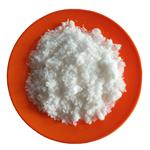Chemical Properties
light brown to grey fine crystalline powder. It precipitates leafy crystals from chloroform and needle-like crystals from toluene. Freely soluble in water and alcohol, slightly soluble in ether and hot chloroform.
Uses
Chlorohydroquinone is a component of polyethers based on organotin with potential application to breast cancer treatment via growth inhibition. Also a component in the synthesis of contraceptive agents in pharmaceutical compounds. It is also used within hydroxylation and catalysis organic reactions in the synthesis of pharmacologically active phenolic compounds.
Definition
ChEBI: Chlorohydroquinone is a benzenediol that consists of hydroquinone bearing a single chloro substituent. It has a role as a metabolite. It is a member of monochlorobenzenes and a member of chlorohydroquinones.
Preparation
Chlorohydroquinone is obtained by reacting p-benzoquinone with hydrochloric acid. First dissolve p-benzoquinone with chloroform and pass dry hydrogen chloride gas under cooling to obtain.
Application
Chlorohydroquinone is a benzenediol that consists of hydroquinone bearing a single chloro substituent. It has a role as a metabolite. It is a member of monochlorobenzenes and a member of chlorohydroquinones. Chlorohydroquinone is used in photographic developing solutions. It is also a bactericide.
Safety Profile
Poison by ingestion and
intraperitoneal routes. Moderately toxic by
skin contact. Experimental reproductive
effects. When heated to decomposition it
emits toxic fumes of Cl-. See also
CHLORIDES.
Purification Methods
Crystallise the hydroquinone from CHCl3 or toluene. [Beilstein 6 IV 5767.]





